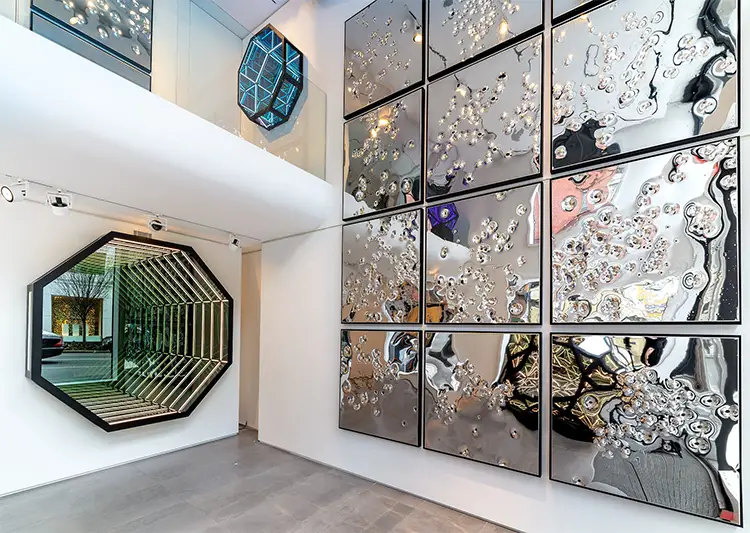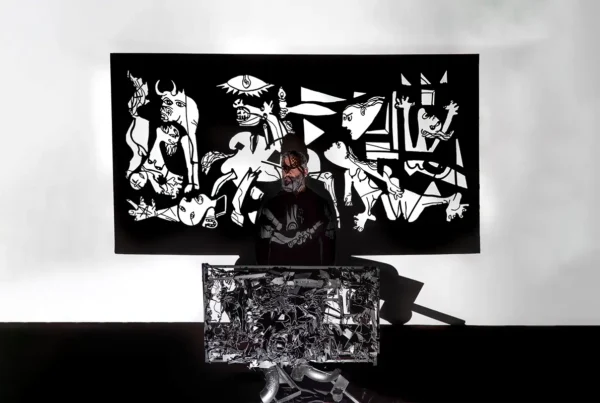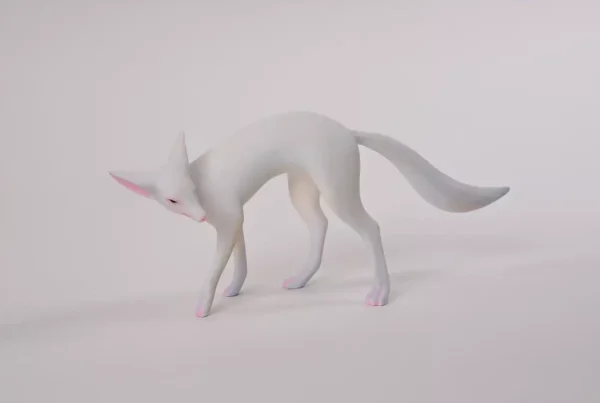Sacred Symmetries and the Language of Light
Anthony James has emerged as one of the most conceptually arresting visual artists working today, bridging the technological with the transcendent through his immersive sculptures. With a foundation in painting earned at Central Saint Martins in London between 1994 and 1998, James transitioned from the static nature of traditional canvas into dynamic, sculptural environments that alter perception and provoke introspection. His work exists at the crossroads of philosophy and materiality, consistently interrogating how form, light, and repetition can serve as conduits to deeper awareness. Through stainless steel, glass, and LED lighting, James constructs vast geometries that appear to extend into endless dimensions, inviting viewers into a contemplative dialogue with space and time.
Central to James’s practice is an aesthetic fusion of Minimalism, Transcendentalism, and the West Coast Light and Space movement, yet his interpretation of these traditions feels uniquely contemporary. Rather than adhering strictly to historical methods, James incorporates digital logic and architectural precision to construct objects that function as both sculptures and meditative environments. His signature series, Portals, embodies this synthesis most clearly—modular, mathematically grounded forms that invite a sensory experience rather than simple visual admiration. Inspired by Plato’s Timaeus, these structures give geometry a physical presence that can be walked around, contemplated, and even emotionally inhabited. Viewers often describe the experience of encountering a Portal as cosmic or spiritual, revealing the artist’s ability to translate abstract thought into deeply felt encounters.
Though rooted in ancient philosophical ideas, James’s work consistently challenges the boundaries of contemporary exhibition contexts. From Art Basel to remote natural landscapes, he positions his sculptures in ways that dismantle the exclusivity often associated with conceptual art. In 2023, he became the first visual artist to exhibit on all seven continents, a feat marked by his installation of a Portal sculpture at White Desert’s base near the South Pole. In this stark and pristine environment, geometry and light met ice and silence, symbolizing a universal language unbound by culture or geography. This milestone is emblematic of James’s commitment to making metaphysical experience physically and globally accessible.
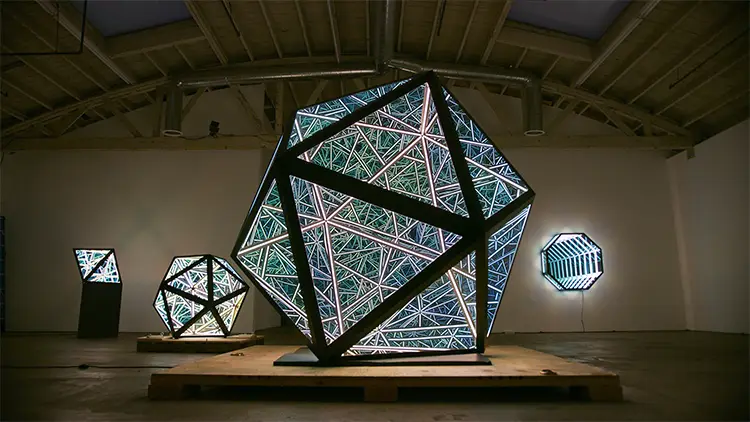
Anthony James: Geometry as Revelation
Since launching his Portals series in 2008, Anthony James has sustained a creative dialogue between the sacred and the scientific. The series originated from his fascination with the elemental geometries described in Plato’s Timaeus—archetypal forms representing Earth, Air, Fire, and Water. These ideas crystallized into sculptural expressions that combine symmetry, precision, and illumination. Constructed from industrial materials like glass, steel, and LED lights, each Portal becomes a spatial embodiment of both ancient wisdom and modern design. They suggest infinity not as an abstract concept, but as something visible and almost tangible, offering viewers a glimpse into what James calls “the divinity inside us all.” These works operate as meditative tools, not in a religious sense, but as prompts for heightened awareness.
The metaphysical undertones of his sculptures are counterbalanced by a meticulous attention to technical execution. James employs materials with distinct characteristics—steel for permanence, glass for transparency, and LEDs for vibrancy—to engineer structures that both reflect and refract their surroundings. This interplay of light and surface creates an illusion of endless depth, pulling the viewer into a visual continuum. It’s an approach rooted not in illusion for illusion’s sake, but in an effort to visually represent infinite recursion and spiritual introspection. In many ways, James is less concerned with the object itself than with the experience it catalyzes. He wants the audience to feel enveloped, to stand before something that collapses external context and draws attention inward.
His installation in Antarctica stands as a culmination of this vision. Positioned against an environment devoid of human interference, the sculpture underscores geometry as a universal constant—a silent language that precedes culture and transcends era. By placing a Portal in such a remote and uncorrupted landscape, James emphasized the purity of form and the resonance of mathematical order. The contrast between the work’s engineered precision and the chaotic grandeur of nature accentuated the thematic core of his practice: the search for unity between matter and meaning. This project did not just expand his geographical reach; it reinforced his belief in the timeless, borderless potency of sacred form.
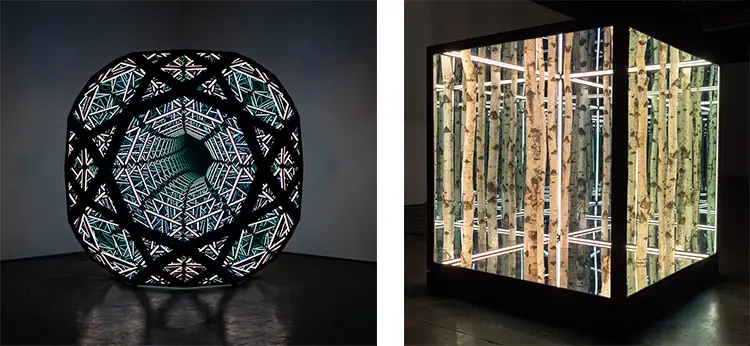
Monuments to Perception
Beyond private collections and galleries, Anthony James has extended his practice into major public installations, where interactivity and scale heighten the sensory power of his work. These projects emphasize his commitment to democratizing access to immersive, contemplative experiences. One such instance occurred at the 2022 Chelsea Flower Show, where James installed three crystalline light sculptures that mimicked the morphology of natural crystal formations. Alongside these, he presented sixteen color-shifting sculptures at the Saatchi Gallery, all linked through a central algorithmic system he likened to a mycorrhizal network—an allusion to the subterranean communication systems found in birch forests. The exhibition drew parallels between biological and technological networks, reinforcing the idea that everything—organic or artificial—is interconnected.
James continued this trajectory with his monumental sculptures at Marble Arch in Hyde Park. These three Light Field structures, seen by over 250,000 people within three months, offered a rare opportunity for everyday passersby to engage with high-concept art in a casual context. Unlike the hushed reverence of a museum, these public encounters encouraged spontaneous reactions—children gazing into the illuminated void, commuters pausing for unexpected reflection. These installations weren’t just about aesthetic allure; they functioned as accessible spaces for introspection and shared wonder. They reinforced James’s belief that art should be an experiential equalizer, capable of reaching diverse audiences regardless of their familiarity with art history or theory.
Such visibility has carried James’s work far beyond traditional art platforms. His Portals have appeared in major international art fairs like Art Basel, but also in mainstream culture, most notably in the film Glass Onion. For James, this crossover into popular media doesn’t dilute his message—it amplifies it. By appearing in contexts outside the white cube, his sculptures maintain their conceptual integrity while expanding their resonance. He remains clear that the medium is secondary to the experience. Whether in a cinematic frame, an urban square, or the wilderness of Antarctica, the work is consistent in its purpose: to create a moment of stillness in a distracted world, a brief yet profound alignment with something larger than the self.
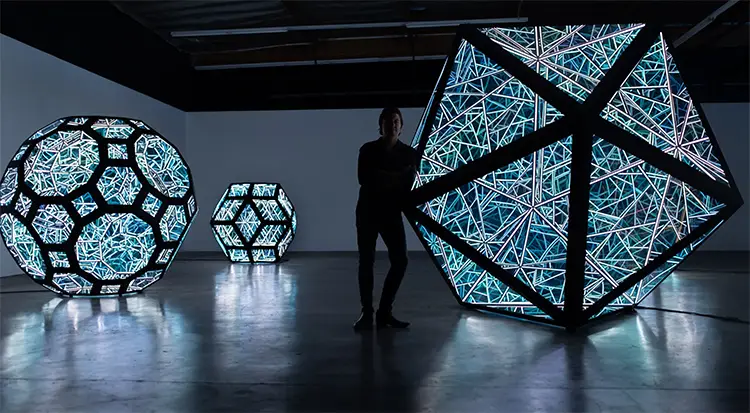
Anthony James: Ritual, Destruction, and the Sculptural Self
Long before the polished geometry of the Portals defined his public profile, Anthony James produced a raw and provocative work that marked a decisive break in his artistic journey. The piece, titled Kθ, involved the ritualistic destruction of a Ferrari, which he set ablaze in a birch forest and then sealed in a glass-and-steel vitrine. Completed in 2008, the same year his Portals began, Kθ signified a radical shift—from ego-driven symbols of consumption to spiritual exploration. The work drew from ancient themes of death and rebirth, with the birch forest representing purity and renewal, while the Ferrari stood in for vanity, excess, and mortality. Encased like a relic, the charred remains became a sculptural exorcism, a way for James to shed a former identity and embrace a more spiritually resonant practice.
The materials that now define his sculptures—titanium, steel, glass, and LED lighting—are not arbitrary choices but form a cohesive visual language. Each component contributes a distinct symbolic and structural role. Steel and titanium evoke permanence and industrial strength, grounding the work in the physical world. Glass introduces a dynamic quality, both revealing and concealing, while also reflecting the viewer within the work. LEDs bring motion and energy, acting as carriers of light—the most immaterial of substances. This blend of hardness and illumination gives James’s sculptures a paradoxical quality: they are both solid and ephemeral, weighty and weightless. Through these juxtapositions, he constructs objects that appear as emissaries from a future that remembers the past.
His ongoing engagement with sacred geometry deepens this sense of timeless relevance. Drawing inspiration from naturally occurring patterns—from snowflakes to shells—James sees geometry as a kind of universal syntax. These patterns serve not just as formal guidelines but as ideological foundations. They represent balance, symmetry, and interconnectedness. For James, geometry is not just an aesthetic—it’s an ethical and spiritual framework. When applied to his large-scale installations, this system acts as a bridge between ancient cosmologies and contemporary technologies, grounding the intangible in physical form. In doing so, Anthony James offers more than sculpture; he proposes a model for perception itself, one that honors both the material and the ineffable.
